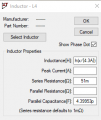I'm dealing with a problem finding a solution to output ripples.

How can I reduce this output ripples using imperfect capacitors and imperfect inductors ?
I've tried using 330u Tantalum capacitor but it was imperfect so the series induction made it look like in the picture.
I also have the same problem in other circuits, so maybe someone know how to reduce these output ripples for the Converters

How can I reduce this output ripples using imperfect capacitors and imperfect inductors ?
I've tried using 330u Tantalum capacitor but it was imperfect so the series induction made it look like in the picture.
I also have the same problem in other circuits, so maybe someone know how to reduce these output ripples for the Converters
Attachments
-
3.5 KB Views: 2

















